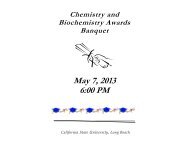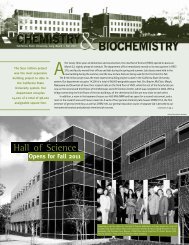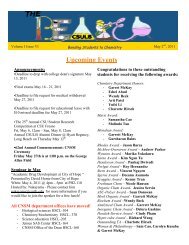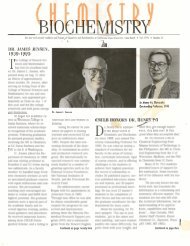2010 - California State University, Long Beach Department of ...
2010 - California State University, Long Beach Department of ...
2010 - California State University, Long Beach Department of ...
You also want an ePaper? Increase the reach of your titles
YUMPU automatically turns print PDFs into web optimized ePapers that Google loves.
Reports from Faculty<br />
On a personal level, my wife, Sarah, and I<br />
took a little time to visit Seattle in June 2009<br />
for the first time. While there, we took a fourhour<br />
glass-working lesson at an art glass<br />
foundry. It was my first time working glass at<br />
this level since my undergraduate scientific<br />
glassblowing class. It was fun and challenging,<br />
and we were able to make a few items<br />
shipped to us after annealing.<br />
Dr. Shahab Derakhshan<br />
In my research group, we intend to<br />
establish a broad, solid-state synthesis program,<br />
with the goal <strong>of</strong> discovering and characterizing<br />
novel compounds with desired physical<br />
properties for some specific applications.<br />
Accordingly, my research is focused on two<br />
different, but related, areas, namely energy<br />
related materials and magnetic materials.<br />
The past year has been an exciting year<br />
for me as I designed the laboratory setup and<br />
eventually purchased and installed some <strong>of</strong><br />
the major pieces <strong>of</strong> equipment and built others<br />
with great support from the CNSM science<br />
shop. I am glad to say that these pieces have<br />
now come together, and our lab is operational.<br />
Our materials preparation lab is located in<br />
MLSC 332, and our state-<strong>of</strong>-the-art powder<br />
X-ray diffractometer was installed in MLSC<br />
302. I am very fortunate to have the opportunity<br />
to work with five very talented and<br />
enthusiastic undergraduate students in my lab.<br />
Alan Tran and Kenny Tran are trying to discover<br />
new materials with some interesting<br />
magnetic properties. Ryan Clark, Malinda Tan<br />
and Sophia Nguyen are searching for new<br />
functional materials with superior thermoelectric<br />
efficiency.<br />
Another piece <strong>of</strong> exciting news for us<br />
was that my research proposal entitled<br />
“Design, Synthesis and Physical Properties <strong>of</strong><br />
Some Novel Brownmillerite Compounds” was<br />
recognized for a Single Investigator Cottrell<br />
College Science Award by the Research Corporation<br />
for Science Advancement.<br />
We have also started a collaborative<br />
research project with Dr. Sergio Mendez’s group<br />
from the <strong>Department</strong> <strong>of</strong> Chemical Engineering.<br />
Since my appointment at CSULB in<br />
August 2009, I have published two articles in<br />
peer-reviewed journals. Some <strong>of</strong> the work<br />
described in one <strong>of</strong> these articles, published in<br />
the Journal <strong>of</strong> Alloys and Compounds, was<br />
done at CSULB.<br />
Dr. Tom Maricich<br />
At commencement this spring, I was<br />
honored to be selected as grand marshal for<br />
the College<br />
<strong>of</strong> Natural<br />
Sciences and<br />
Mathematics. I<br />
kept the graduates<br />
in line<br />
with my mace.<br />
My research<br />
group is continuing<br />
our<br />
studies <strong>of</strong><br />
“Click Alkylations”<br />
by sulfonimidates<br />
on various nucleophiles (Igor<br />
Izotov on phosphonic and phosphoric acids,<br />
Michael Fimbres on thiols, Holly Phung and<br />
Marilyn Ton on alcohols, and Francisco<br />
Rodriguez on new chiral sulfonimidates).<br />
Francisco graduated this year top in his class<br />
and received both the Robert B. Henderson<br />
and Robert D. Rhodes Awards. He will begin<br />
his Ph.D. studies in organic chemistry at Vanderbilt<br />
<strong>University</strong> this fall. More details about<br />
our research can be found on my updated<br />
department website.<br />
Another student (from the Food Science<br />
<strong>Department</strong>) is doing research on a project<br />
generated from my consulting activities as an<br />
expert witness. I have been retained on several<br />
cases involving severe scalp burns, which<br />
resulted from the exotherm <strong>of</strong> water in hydrogen<br />
peroxide with sodium metasilicate in hair<br />
bleaching powder. This happens when these<br />
chemicals are mixed into a paste and applied<br />
to the hair over the scalp. Sokrith Sea is testing<br />
various mixtures at different temperatures<br />
to correlate the results and determine which<br />
commercial highlighting bleaches are hazardous<br />
and which appear to be safe.<br />
On another level, I have been planting<br />
seeds <strong>of</strong> future chemists by making presentations<br />
at my grandson’s second and granddaughter’s<br />
third grade classes. The children<br />
performed hands-on experiments with sources<br />
<strong>of</strong> carbon dioxide and learned that the bubbles<br />
in cupcakes are filled with CO2. By wearing<br />
placards <strong>of</strong> H, O and C, they held hands<br />
and demonstrated chemical reactions. Afterwards,<br />
some students said that they wanted<br />
to become chemists.<br />
Finally, although this fall will be my last<br />
semester <strong>of</strong> formal teaching, I will continue<br />
to mentor students, develop my research<br />
projects, warn the public about hazardous<br />
consumer chemicals and catch a few good fish<br />
in Sitka, Alaska (see photos on my webpage).<br />
Dr. Steve Mezyk<br />
In the past 12 months, the CSULB Mezyk<br />
RadKEMTM group has continued to focus on<br />
research, completing many old projects as well<br />
as starting endeavors in our new area <strong>of</strong> nuclear<br />
chemistry. Our efforts for this year resulted in<br />
11 peer-reviewed papers and reports published,<br />
an additional nine papers accepted for journal<br />
and symposium publication, 24 conference<br />
presentations, and receiving nearly $1.8 million<br />
in new grants from the <strong>Department</strong> <strong>of</strong> Energy<br />
and the National Science Foundation. This success<br />
was highlighted by my publication <strong>of</strong> five<br />
review articles, an invited expert talk at the<br />
ACSEPT nuclear reprocessing conference in<br />
Portugal and recent recognition by the university<br />
in my receiving the CSULB Provost’s Award<br />
for Impact Accomplishment <strong>of</strong> the Year in<br />
Research, Scholarly or Creative Activities. It<br />
has truly been another amazing year.<br />
As always, my hardworking group<br />
changed this year, with graduations and new<br />
students joining. Timothy Feliciano completed<br />
his final year with me this summer, finishing<br />
up his Beckman project on the radical-based<br />
removal <strong>of</strong> antibiotic metabolites from waters<br />
and graduating with his B.S. degree in biochemistry.<br />
He is currently applying for M.D./Ph.D.<br />
schools across the country. Thomas Neubauer<br />
completed his M.S. degree on the redox chemistry<br />
<strong>of</strong> sulfonamide antibiotics and has now<br />
started his Ph.D. degree at U.C. Riverside in<br />
solid-state NMR. Jonathan Kleinman also<br />
completed his M.S. degree on the roles <strong>of</strong> dissolved<br />
organic matter in advanced oxidation<br />
process treatment <strong>of</strong> chemically contaminated<br />
waters and is now back to full-time employment.<br />
We will also be losing Tom Cullen and<br />
Andrea Hewitt at the end <strong>of</strong> <strong>2010</strong>, when they<br />
complete their remaining courses. New undergraduate<br />
research students in the group are<br />
Jeremy Scheeler, who will be working on<br />
nitrosamine carcinogenesis kinetics, and<br />
Mathew Stephens, who will be studying the<br />
temperature-dependent kinetics <strong>of</strong> using radicals<br />
to remediate dry-cleaning fluid contaminated<br />
soils and waters. Two new graduate<br />
students have joined us: Charlotte Hirsch is<br />
investigating the radical chemistry involved in<br />
musk ketone (perfume components) removal<br />
from waters intended for reuse, and Hanqing<br />
Pan is looking at troposphere aerosol chemistry<br />
<strong>of</strong> nitrate and hydroxyl radical reactions<br />
with isoprene at low temperatures.<br />
Continued on pg. 10, Reports from Faculty<br />
9



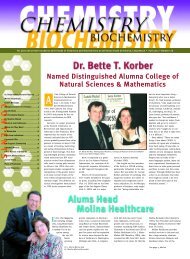
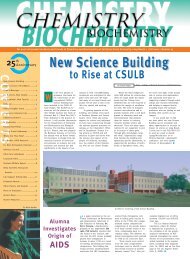
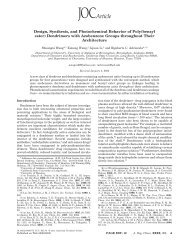
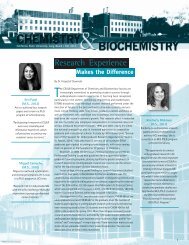
![Volume 4, Issue 3 [November 2012 pdf] - California State University ...](https://img.yumpu.com/34605825/1/190x245/volume-4-issue-3-november-2012-pdf-california-state-university-.jpg?quality=85)
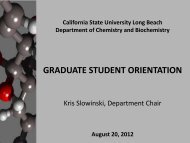
![Volume 5, Issue 2 [April 2013 pdf] - California State University, Long ...](https://img.yumpu.com/33273195/1/190x245/volume-5-issue-2-april-2013-pdf-california-state-university-long-.jpg?quality=85)
